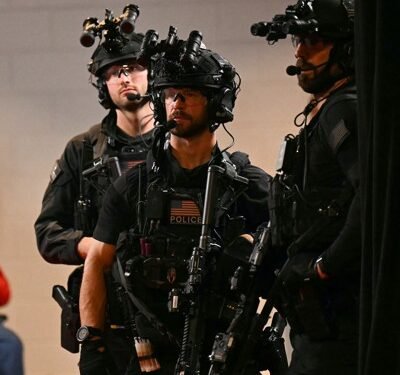An emerging picture indicates that better communications tech between agencies may have prevented the Trump shooting—and that getting the Secret Service, law enforcement, and the Department of Homeland Security on the same page communications-wise could be instrumental in preventing future assassination attempts.
A congressional report from late last month notes that the Secret Service didn’t have the right radios to talk to Butler County police—because they forgot to pick them up before the event—and that likely played a key role in the poorly coordinated response.
“On [July] 12, the Butler County ESU Commander personally reminded the USSS counter-sniper teams to pick up their assigned radios at the ESU Command Post RV, which was positioned according to planning at the Butler Fairgrounds, the following morning before 1100 hrs. It didn’t happen,” notes the August 12 report from the office of U.S. Rep. Clay Higgins, R-La..
That failure speaks to a larger equipment problem: Secret Service, DHS, military, and police radios don’t all work together.
On July 30, days after the head of the U.S. Secret Service resigned, the acting director Ronald Rowe told lawmakers that a key communication gap contributed to the failure to prevent the shooting.
Local law enforcement spotted the attacker, Thomas Matthew Crooks, “scurrying” to position himself to take a shot from the roof of a nearby building. But the unified command on the ground relayed only part of what was going on to the Secret Service: namely that they were responding to an incident.
“Apparently, not having that real-time information is what really hindered us in being able to understand more than: it was just the locals working an issue at the three o’clock. There was actually a little bit something more urgent than that,” Rowe told lawmakers.
Because there were so many different varieties of communications equipment, local law enforcement and SWAT personnel couldn’t communicate directly with Secret Service officers. It is technically possible, Rowe said, “ But it would take a long time to get it done, and for a one-day or an eight-hour operation, it requires a lot, and it would be months of planning, of knowing that we are going to go to this particular jurisdiction and that we’re going to need your frequencies, the keys, and we’re going to need to load you into our radios.”
This is also a problem for the military, particularly those elements that often work with partner militaries, like special operations forces.
Ari Schuler, the CEO of goTenna, a company that provides mobile mesh network technology to the military, Customs and Border Patrol, and others,, said the technical barriers to better-incorporated communications aren’t as big as the policy and training issues around getting interoperable equipment to agencies. Adopting new tools and tech like the Team Awareness Kit, plus the ubiquity of modern smartphones, means there are plenty of ways to collect and distribute a real-time information picture to everyone who needs it.
Mobile mesh networks that bridge the gaps between different communications systems, protocols, etc., could help link everything together in a single data web that could then be distributed to many different types of devices securely.
The problem is partly due to domestic agencies, including the Secret Service, just not getting the resources they need, he said.
“I was at CBP and DHS for close to a decade. When you look at both the resourcing and the training regimen of military versus law enforcement, it is very different. DOD had an order of magnitude or more overall resources than we did at DHS,” Schuler said.
But training and exercising is another barrier to wider adoption, he said. The military has a lot of time to conduct exercises to see what is and isn’t working in the field, whereas many law enforcement agencies and the Secret Service do not have time to take away from their regular duties for similar exercises.
“When you are in the military, most of your time is training, unless you’re operating. When you’re in law enforcement, you have very few contiguous weeks carved out, and a lot of it is for qualifying on your weapon and all the different—depending on what your role is—support things and things like that,” he said.
These are the sort of gaps lawmakers don’t spend much time thinking about until an incident occurs. But that’s started to change since the July assassination attempt.
During the hearing, Sen. Jon Ossof, D-Ga., asked Rowe: “The inability swiftly to link personnel from disparate jurisdictions at the local, state, and federal level, is a vulnerability for the nation, is it not?”
Rowe responded, “I would think, based on my experience, being able to talk to other agencies real-time certainly would assist in that response.”










